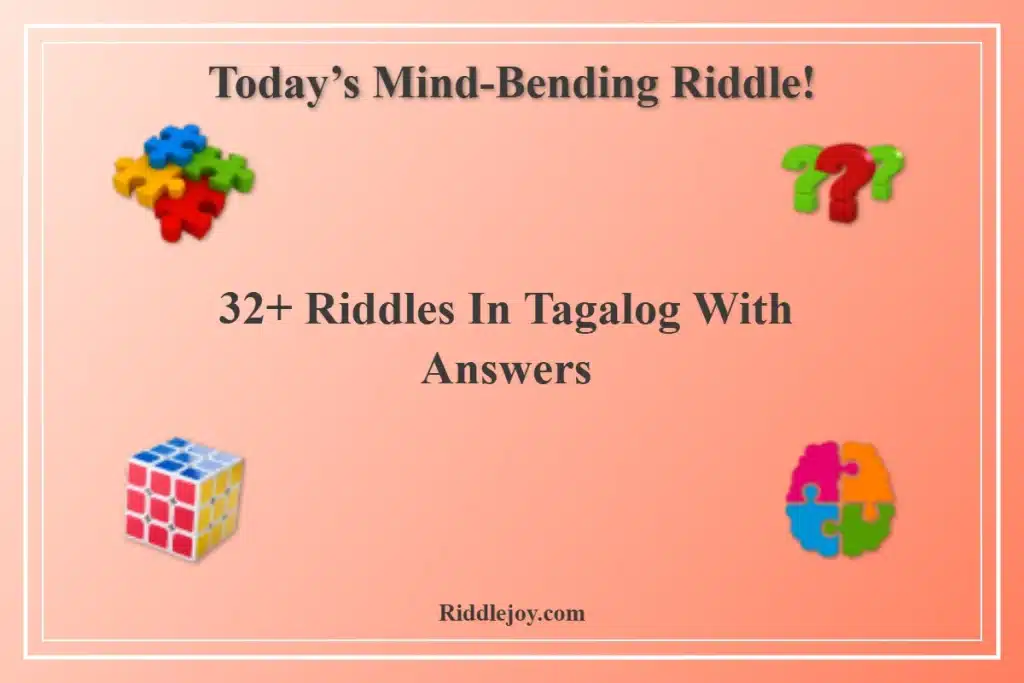Riddles — or bugtong in Tagalog — are a beloved part of Filipino culture. These short, poetic puzzles often describe everyday objects in imaginative and mysterious ways, challenging the mind and tickling the curiosity. Passed down through generations, riddles in Tagalog are more than just games — they reflect local traditions, nature, and humor.

Whether you’re learning Filipino, teaching kids, or just love clever wordplay, these riddles in Tagalog with answers will entertain and enlighten. Each riddle comes with an English explanation to help you understand the wordplay and context behind the answer.
1. Riddle:
Isang balong malalim, punong-puno ng patalim.
- Answer: Bibig
- Explanation: The mouth is described as a deep well filled with blades — symbolizing teeth.
2. Riddle:
Bumili ako ng alipin, mataas pa sa akin.
- Answer: Sumbrero
- Explanation: A hat is worn on the head, making it higher than the person who owns it.
3. Riddle:
May bintana na, wala namang bubungan.
- Answer: Ilong
- Explanation: The nose has nostrils like windows, but no roof over them.
4. Riddle:
Kung kailan mo pinatay, saka pa humaba ang buhay.
- Answer: Kandila
- Explanation: A candle “lives” when lit — it burns down and shines as it dies.
5. Riddle:
Kay lapit-lapit na sa mata, di mo pa rin makita.
- Answer: Isip
- Explanation: The mind is abstract — it’s near us yet cannot be seen.
6. Riddle:
Dumaan ang hari, nagkagatan ang mga pari.
- Answer: Zipper
- Explanation: The “king” represents movement, and the “priests biting” describes how a zipper closes.
7. Riddle:
Araw-araw nabubuhay, buwan-buwan namamatay.
- Answer: Kalendaryo
- Explanation: A calendar renews daily and finishes each month — a time-based metaphor.
8. Riddle:
Hindi pari, hindi hari, nagsusuot ng sarisari.
- Answer: Hanger
- Explanation: A hanger isn’t a person but wears many clothes — like a wardrobe servant.
9. Riddle:
Basa na, hindi pa naliligo.
- Answer: Isda
- Explanation: Fish live in water and are always wet without ever bathing.
10. Riddle:
Dalawang batong itim, malayo ang nararating.
- Answer: Mata
- Explanation: Our eyes are dark and small but can see far — a poetic description of vision.
11. Riddle:
May ulo, may tiyan, walang likod, walang katawan.
- Answer: Plato
- Explanation: A plate has a head (top) and base (belly) but no back or body — a literal twist.
12. Riddle:
Isa ang ulo, ang katawan ay pito.
- Answer: Bahaghari
- Explanation: The rainbow is seen as one entity (head) with seven colors (body parts).
13. Riddle:
Di naman tao, may buhok sa ulo.
- Answer: Mais
- Explanation: Corn isn’t human, but the top of an ear of corn has “hair.”
14. Riddle:
Binili mo para kainin, pero hindi mo kinakain.
- Answer: Plato o kutsara
- Explanation: You buy plates or utensils to help you eat, but don’t eat them.
15. Riddle:
Hinila ko ang baging, sumigaw ang matsing.
- Answer: Kampana
- Explanation: Pulling the vine (rope) makes the monkey scream (the bell rings).
16. Riddle:
Lumuluha walang mata, lumalakad walang paa.
- Answer: Gripo
- Explanation: A faucet drips (cries) and flows (walks) but lacks eyes or feet.
17. Riddle:
Isang tabo ng ginto, nakasakay sa bato.
- Answer: Itlog ng bibi
- Explanation: The golden yolk (ginto) sits in a shell (bato) — describing a duck egg.
18. Riddle:
Di mo dala, dala ka niya.
- Answer: Sapatos
- Explanation: Shoes carry you — not the other way around — a reversal of expectations.
19. Riddle:
Balong malalim, puno ng patalim.
- Answer: Bibig
- Explanation: A repeat due to popularity — describing the mouth with teeth as blades.
20. Riddle:
Isang matandang hukluban, nakakabasa kahit walang mata.
- Answer: Aklat
- Explanation: A book provides reading material without having eyes — it’s read, not reading.
21. Riddle:
Munting bahay, puno ng laman, bintana’y walang salamin.
- Answer: Bibig
- Explanation: Again, this refers to the mouth — a small house full of teeth with no glass (no eyes).
22. Riddle:
Aling hayop ang nauuna sa karera pero laging natatalo?
- Answer: Kabayo sa chess
- Explanation: The knight (kabayo) in chess moves first but often loses — a logic twist.
23. Riddle:
May dalawang magkaibigan, laging magkadikit pero ‘di nagkakatinginan.
- Answer: Tainga
- Explanation: Ears are always on either side of the head but never face each other.
24. Riddle:
Bata pa si Nene, marunong nang manahi.
- Answer: Ahas
- Explanation: A snake (ahas) slithers like stitching — hence the sewing metaphor.
25. Riddle:
Ulo’y nasa langit, ang katawan ay nasa lupa.
- Answer: Upo
- Explanation: The gourd vine grows from the ground with fruit hanging above — head in the sky.
26. Riddle:
Sa araw ay bungbong, sa gabi ay dahon.
- Answer: Banig
- Explanation: A banig (mat) is rolled up by day and spread like a leaf at night — a clever image.
27. Riddle:
Dumaan ang hari, lahat ay napahawi.
- Answer: Hangin
- Explanation: Wind moves unseen, like a king making everything bow or move.
28. Riddle:
Bahay ni Ka Juan, iisa ang hagdanan.
- Answer: Posporo
- Explanation: A matchbox has one way in/out — metaphorical “stairs” — and holds matches.
29. Riddle:
Dala mo araw-araw, pero di mo nakikita.
- Answer: Pangalan
- Explanation: You always carry your name, but it’s invisible — part of your identity.
30. Riddle:
Hindi tao, hindi hayop, nagsusuot ng sumbrero.
- Answer: Kabute
- Explanation: Mushrooms look like they wear hats — a natural and visual comparison.
31. Riddle:
Kayang gawing bundok ang munting hukay.
- Answer: Pala